| Rashidun Caliphate | ||||||
| ||||||
| ||||||
| Motto "لا إله إلا الله" "No god but The God" | ||||||
Core territory of the Rashdiun Caliphate
| ||||||
| Capital | Damascus (1599-1692) Cairo (1693-1718) | |||||
| Languages | Arabic, Amharic, Farsi | |||||
| Religion | Sunni Islam Coptic Christianity Orthodox Christianity | |||||
| Demonym | Rashidun | |||||
| Government | Caliphate | |||||
| Caliph | ||||||
| • | 1599-1605 | Khalid Abdul Hamid Salih | ||||
| Historical Era | Early Modern | |||||
| • | Sixth Fitna | 1594 - 1593 | ||||
| • | Disestablished | 1718 | ||||
| Population | ||||||
| • | 1600 est. | 47 million | ||||
| • | 1650 est. | 68 million | ||||
| Currency | fils | |||||
The Rashidun Caliphate (Arabic, اَلْخِلَافَةُ لرَّاشِدَةُ al-Khilāfah ar-Rāshidah) is a theocratic, elective nation located in the Middle East, North and East Africa. After the Abbasid Caliphate had been overthrown in the Sixth Fitna in 1599, the Ulema (or Council of Senior Scholars) took full control over both the nation and the religion of Islam. Rather than installing a new dynasty, the Ulema created a system of non-dynastic, elected Caliphs expanded from the former office of Grand Vizier. This system was heavily based on the Old Rashidun Caliphate, the original dynasty to rule Islam from 610-668 AD.
The Caliphate is generally remembered for bringing Islam into the modern world, particularly by uniting the sects of Sunni and Shia. Since its founding, the Caliphate is also the primary forefather of most representative government outside of Europe.
History[]
An Enlightened Caliphate[]

Siege of Heraklion (1596)
Immediately after the end of the Sixth Fitna, Caliph Salih was left with rebuilding a nation shaken up by the plagues and wars at the end of the Abbasid Caliphate. As the infrastructure of the nation was rebuilt, so too was a new cultural outlook of the nation was made from the ground up. At the turn of the 17th century, the Caliphate had completely turned towards an identity of cultural and religious advancement, seeing their representative government as symbolic of a modern nation-state. Conscientious of this change, Salih opened up an international celebration at Mecca for the 1000th anniversary of the Caliphate in 1601.
Other states outside of Europe eventually worked at copying the style of government the Caliphate had which proved to be successful. By the middle of the 17th century, the states of Iran, Aryavarta, Bengal and Karnad all used various forms of elective monarchy like the Rashidun. This was also emulated by the states that broke off from the Rashidun like Krete and Balkha.
Art and literature thrived more than in the Abbasids, based on styles imported from both Europe and Asia. In order to progress this culture further, Salih emphasized a reform and standardization of education that continued throughout that generation. This especially helped when the Tomb of Al-Mu'stasim was uncovered in 1602.
Externally, the Rashidun envisioned the spread of influence to the whole known world. This was particularly felt eastward, where the Arab-Indian Company still helped encourage trade through the Arab protectorates to China and Korea. In order to maintain this trade, the Caliphate supported the key governments such as Bahmani and Tali. In addition, peaceful trade was opened with Aryavarta, although they declined participating in the Arab-Indian Company.
In the west, the Caliphate sought to mitigate the situation with the Ottoman Empire and the Tsardom of Bulgaria. The Ottomans had retained some influence over the Ulema in the wake after the Sixth Fitna, but quickly they went into decline again. At one time the Caliphate tried to send support to Philip of Corfu, the Greek princely revolt in the beginning of the 17th century. This was exasperated by the instability of Greek population, especially while the Hitlerite wars were going in Europe. The Ulema also considered annexing the Ottoman, but this was believed to be much too costly overall. In 1617, the Ulema eventually decided to remove the Ottoman colony of Crimea and give it to the Kingdom of Pontus, a more stable vassal.
To progress the theocracy of the Rashidun, much work was done to proselytize Islam, particularly in Southeast Asia and central Africa. As soon as Morocco began their colony in Laurentia in 1601, the Caliphate sent hundreds of colonists along with the Ayatollah Uthman Ibn Adfal. As Arawaka in Brazil accepted Muslim influence in the 1630s, a local Kazir was appointed there as well.
The Golden Jihad[]
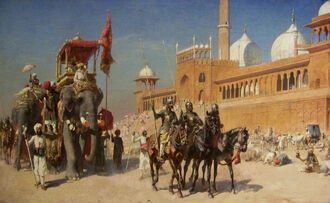
Persian armies march in Sindh
In 1602, Aryavarta invaded the Andaman Islands, and ultimately negotiated for its annexation from Burgundy. The Caliphate, initially desiring a colonial war with Burgundy, shifted focus from this event to organize a full Jihad against India. The justification initially was based on Aryavarta breaking the Peace of India by involving itself with Southeast Asian colonies. However, later on the Caliphate drew up other charges against Aryavarta copied from the older states of the Delhi Sultanate, including the Indian Myth once used against the Majapihut Empire.
The course of the war, mainly led by the Admiral Reis Al-Nasser, focused on invading Gujarat, while supporting Bengal to revolt and take the eastern provinces. States of Persia, Bahmani, and Swahili also participated by invading parts of India, while Oman alone remained neutral. Seeing the logistics as incapable of crushing the Hindu empire, the coalition focused on taking all the coast from India as colonies of the various participants. Aryavarta finally capitulated in the Treaty of Mylapore in 1605, granting the Arab-Indian company total dominance of South Asia except for Oman and Europe.
Several effects came from the Golden Jihad. One was the beginning of the Rashidun colonial empire across the Indian Ocean. In 1611, one last addition to this colonial empire was the Sultanate of Aceh that became a protectorate. Another affect was the final construction of the Fatha Al-Farun, as the new naval prowess of the Caliphate was now significant. Along the same lines, the Rashidun navy was upgraded to control these new colonies. After it was completed, however, the Ulema kept it under restricted use. It was used only for Arab ships until special authorization was given to the Roman Pope , and later briefly to Venice.
Seeing the difficulty initially of maintaining colonies in both the Mediterranean and the Indian Oceans, Krete was released as an independent state. The island of Naxos was first annexed by the Caliphate, after it had been under Arab rule for almost 200 years, but ultimately sold to Belka. One provision, however, was that the Arab population is not removed from Naxos as long as there is sand on the shore.
Religious Tolerance[]

Council of Basra, 1619
After Salih died, his son-in-law Ibn Harb was elected the next Caliph. His tenure was brief, however, as it became apparent his election was founded more on his relation to his predecessor than actual piety, and so he was deposed by the Ulema in 1607. This formed the precedent of control by the Ulema that was key in the rest of the Rashidun's history.
Al-Ruqayyah proved to be much more pious than his predecessors, and during his election he promised to keep the office of Caliph more focused on religion than wars. During his tenure, he focused first on making liturgical reforms to Friday prayer, before moving on to abolish African slavery in light of the work of Caliph Al-Mahdi. Ruqayyah felt the Caliphate was being outdone by the Catholic Church in Europe, and so worked to copy western traditions into Islamic practice.
In 1610, the Grand Council of Basra was convened to finally end the split between Shia and Sunni, now that the thousand years of hereditary rule over the Caliphate had come to an end. The Ziyadi leaders from the Shahdom of Iran attended the council and ended the schism then, merging the faiths together. At first, this created new sects in Iran and Africa that were still separated from the main Sunni theology established at Basra, but these were eventually absorbed by the time of Ruqayya's death.
In 1617, Caliph Ajead called the Roman Pope to meet at the Conference of Alexandria, to begin an interfaith dialogue between the two religions. One motivation for this of course was the enlightened nature of the Caliphate, but also there was a need to dislodge the influence Belka and the Orthodox Church had over the Christians in the Middle East. In order to gain the Pope's favor, the Caliph sent him the holy relic of the Pot of Abraham, as well as offered to give the Pope access to the Fatha Al-Farun.
Height of Colonial Power[]

Nabhani raiders clash with Rashidun military
Oman had always been a rival to the Caliphate ever since it started colonization of Indonesia under the Abbasid dynasty. Its geographic isolation and Ibadi religion had kept it as an independent mercantile state for centuries, with only nominal participation within the Arab-Indian Company. In 1612, the Caliphate decided to finally invade Oman by land and unite it the rest of Arabia.
The initial year of the Unification of Arabia swiftly overran the nation, and the Ulema installed the Yoruba dynasty as a puppet government over Masqat. However, the exiled government led by Sultan Junaid Al-Munassif and General Mustansir Al-Obied worked every available resource possible to keep the Yoruba from establishing legitimacy. The new capital of the Nabhani dynasty in Qamar ran a whole navy of defected ships from Arabia, henceforth known as Qamarid pirates. Piracy would continue for many decades after this, but the navies constructed in Sumatra and Aceh would utilize them as privateers.
Obied's forces in Arabia itself held out an unconventional war based in the fortress of Bahla. These Arab rebels were given the title of "Mukhufu" (terrorists) by the Shay Al-Nass. After both of these places were eventually reconquered by the Caliphate in 1616, a personal union was formed to bring the Nabhani dynasty back to ruling in Masqat.
In order to celebrate the Rashidun's new found colonial empire, the Ulema organized the Pan-Islamic games towards the end of the 1610s, hosted in Jeddah and Mecca. Although participants came from around the globe within the Caliphate's domains, the events themselves were poorly organized. With growing influence over Asia, the Caliph was eventually rewarded the title of Shahanshah of Iran in 1623, being the first time the Caliph had entered Esfahan since the Cloaked Jihad. In 1629, Iran fully submitted as a vassal of the Caliphate, and was subsequently placed under the rule of the Amurid dynasty.
Obstructions in Expansion and Development[]

Sri Amangkurat II, ruler of Java that allied with France
As the French colonial empire was just starting in the 17th century, the Caliphate worked towards maintaining a balance of diplomatic relations with the nation. France had remained on peaceful relations and a nominal ally since the Treaty of Tunis, renewed once again in 1614. After France conquered Java and Borneo, then threatened war against Morocco, the Caliphate worked to ease both situations. To this end, the Caliphate came on France's side during their colonial war against Japan in the late 1610s. In the 1620s, during the French succession crisis the Caliphate secretly planted revolutionaries in Java, but these were ultimately caught.
The end of the Unification of Arabia marked the beginning of the scientific revolution in the Middle East. After a generation was raised on the educational reforms of Salih, the new students and scholars of the House of Wisdom began applying the scientific method of Al-Babil to make leaps and bounds in the areas of mathematics, astronomy, and other fields. This period also saw the growth of power for secular administrations like the Shay Al-Nass, as well as the establishment of a judicial court system.
The 1620s saw the height of the scientific revolution, including such developments as vaccinations and models of the solar system. In addition, Euclidean mathematics and Neo-Platonic philosophy took hold over education and scientific development. In 1625, a push was made to update the great library in the House of Wisdom.
Throughout the 1620s, the Benin Civil War raged as a further distabalization of the West African region. Eager to spread control over that region of Africa, the Caliphate organized a Jihad with the states of Morocco and Mali to attack Benin during its time of weakness. Ultimately, Benin proved to be capable of stopping the invasion and crushing the armies of Mali. However, Morocco proved to be dominant over the sea and pushed Benin completely out of its island protectorates, taking part of the Oyo coastline. In the 1630s, the Zulu Empire proved to be a new state of influence in Africa. In 1633, Shaka Zulu visited both Egypt and Belka during the Great Turkish War.
At the same time Morocco was fully transitioning out of inherited slavery, the states in the Indian Ocean were proving more stuck in tradition. The vassal of Oman continued to sell slaves more in secret, while Swahili adapted the contracted servitude into a more formalized slave system.
The Great Turkish War[]
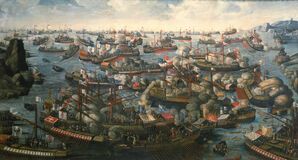
Third Battle of Rhodes, 1642
The Great Turkish War, also known as the Great Crusade or the Great Jihad, was one of the largest conflicts the Caliphate would face in its lifetime. As the Ottoman Empire was steadily declining since its vassalization by the Abbasids, the Tsardom of Belka saw this as the opportunity to call on all the forces of Europe completely conquer Anatolia, as well as liberate the Holy Land. At first, the Crusaders were unsure the full power the Caliphate could bear, but the Rashidun were found completely off guard as no war had been waged with Europe since the Abbasid dynasty. After the Ottomans were completely overrun, with Syria and Cyprus being invaded, the Rashidun called on all the forces of Islam to push back against the invaders. Belka was ultimately forced completely out of the Middle East, but the region of Anatolia proved to be impossible to hold as it collapsed into many components.
On the naval front, the Belkan navy at first crushed the Ottoman fleet and captured the islands of Krete and Rhodes, followed by an invasion of Cyprus. Amir Thaleth, the Emir of Cyprus, proved to be a brilliant commander and ultimately stopped the invasion. After the full force of the Rashidun navy was brought in from the Indian Ocean, the tide turned as both the cities of Rhodes and Ragusa were invaded by the Caliphate.
Contemporary to the Great Turkish War, the Caliphate worked to keep presence in the far east where the bulk of their trade resides. The Korean conquest of China resulting in the new Jin dynasty was quickly accepted by the Caliphate as the official dynasty for trade on the maritime Silk Road. In India, the Muslim Karnad dynasty that overthrew the Bahmani was quickly accepted as part of the Arab-Indian Company. The explorer Salah Ibn Tulun managed to circumnavigate the globe during this time without ever leaving the Rashidun domains.
Administration[]
Federal Government[]
The Caliph[]
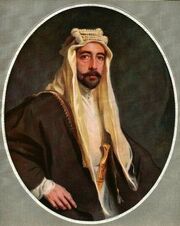
Caliph Salih, 1599
The name Rashidun derives from the Arabic word الراشيدة ("Rashida") which literally means "Rightly-Guided" or "Wisely-Guided". The original Rashidun Caliphate, which ruled from 622-661 AD, was a period of non-dynastic Caliphs that ruled over the early, primordial period of Islam. The name was reused officially in 1600, the 1000th anniversary of the Conquest of Mecca, as a way of describing the new form of elected Caliphs, reportedly as a more formalized version of the original dynasty. The Tables of Government and the Kitaab Al-Kabir stand as the founding documents and constitution of the Caliphate, outlining all the government described here.
The Caliph is an elected office that reigns for life. When the Caliph dies, a delegation of the Ulema is appointed by the Maktab Al-Qudds, which is the secondary authority over religious affairs. This delegation of scholars then vote among themselves in absolute secret who will succeed as Caliph. Once the new Caliph is elected, there is a coronation ceremony that invests the successor with the seal and mantle of Muhammad, as well as the Three Treasures of Egypt. A unanimous vote among the Ulema may remove the Caliph from office as well; however, the Caliph emeritus returns to his former post, and can be re-elected if necessary.
Initially, the Rashidun Caliphs held prestige by being related to the founder of the nation, Khalid Abdul Hamid Salih. The House of Hassan-Salih, reaching back to the first Grand Vizier Mehmed Hassan in the Abbasid Caliphate, were the primary forces to end the Abbasid Dynasty in the Sixth Fitna and invest power to the Ulema. However, the culture of the Rashidun was generally opposed to the idea of hereditary rule, and in 1607 the Ulema voted to remove Ahmed Ibn Harb Salih from power. Since then, it is an unsaid rule that no Caliph can be elected who is related to any previous Caliph.
Other Offices[]
The Caliph is the head of the government, and has executive authority over both religious and secular offices. For most decisions over the state, legislative power is held by the Council of Senior Scholars, or the Ulema. The Caliph has authority to organize the military and executive policies, as well as appoint offices, but these can be revised or superseded by the Ulema. However, the Caliph has the ability to make unilateral orders over religious organization, as well as appoint religious offices without the Ulema's approval, although he can delegate this power if necessary.
The members of the Ulema is limited to 72 members. It constantly evolves to be the most respected religious scholars at any time. However, as the population of the Caliphate grew, many dozens of auxiliary councils of the Ulema also existed as part of the government. Candidate new members of the Ulema are appointed by the Caliph and approved by the remaining members. However, there is much preference towards scholars within the Middle East proper, namely in Syria and Mesopotamia.
Both the Caliph and the Ulema meet at the Citidel of Damascus as the central capital of the empire. The former Abbasid residence of the Qamar Al-Rahim is kept as personal property of the Ulema, but no one lives there.
Under the Ulema, the government is divided between the Maktab Al-Qudds ("The Holy Office") and the Shay Al-Nass ("Thing of the People"). The Maktab Al-Qudds is the head of religious affairs, and is the highest religious office above the ecclesiastical hierarchy created by the Abbasids. The Maktab Al-Qudds also has the job of electing new Caliphs. The Shay Al-Nass is the highest secular court, and makes administrative decisions over secular authorities. Starting in 1616, the Rashidun Caliphate created a full judicial system using jury by ten peers to judge guilt.
The Rashidun retained the same Millet system and administrative structure of the Abbasids before them. In fact, many hereditary nobility within the Caliphate still retained relation to the Abbasid Dynasty. Enclaves of nomadic groups exist in the Middle East as well, primarily within the Arabian peninsula. After the Unification of Arabia, the Bedouin tribes of the empty quarter were given nominal autonomy to retain their culture.
List of Caliphs[]
| Name | Born | Reign start | Reign end | Image |
|---|---|---|---|---|
| Khalid Abdul-Hamid Salih | 1549 (Damascus) | September 15, 1599 | November 5, 1605 | |
| Ahmed Abu Bakr Ibn Harb | 1566 (Damascus) | January 25, 1606 | August 22, 1607 | |
| Nasser Nur-Ramah Al-Ruqayya | 1567 (Antioch) | September 15, 1607 | March 18, 1615 | |
| Ahmed Al-Din Ajead | 1570 (Aden) | August 19, 1615 | February 28, 1621 | |
| Hosna Ubaid | 1569 (Aleppo) | October 1, 1621 | January 5, 1623 | |
| Salah Dhul Al-Qaynan | 1578 (Tabriz) | March 15, 1623 | September 16, 1632 | |
| Walid Al-Hakim | 1585 (Antioch) | December 10, 1632 | March 11, 1637 | |
| Khalid Al-Hajaj | 1588 (Damascus) | March 17, 1637 | June 21, 1645 | |
| Hasan Al-Hakim | 1591 (Antioch) | July 7, 1645 | January 9, 1651 | |
| Walid Al-Hakim (second term) | 1585 (Antioch) | January 20, 1651 | February 2, 1657 | |
| Murad Abu Ahmed Jafar | 1603 (Aleppo) | February 28, 1657 | March 3, 1666 | |
| Abu Bakr Abu Malik Qasim | 1618 (Damascus) | March 20, 1666 | November 15, 1679 | |
| Ahmed Tulun As-Sagheer | 1629 (Damascus) | February 20, 1680 | March 2, 1690 | |
| Malik Al-Baraq | 1622 (Jerusalem) | March 20, 1690 | August 8, 1691 | |
| Aresh Jaffar (not recognized) | 1662 (Aleppo) | August 17, 1691 | September 30, 1691 | |
| Yayha Al-Yunan | 1633 (Cairo) | March 21, 1692 | January 3, 1698 | |
| Hassan Al-Ruqqs | 1640 (Cairo) | March 21, 1698 | July 20, 1705 | |
| Abu Bakr Walid ibn Issa | 1663 (Cairo) | August 19, 1705 | September 11, 1719 |
External Territories[]
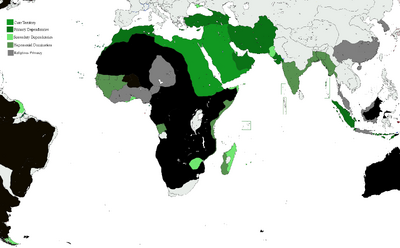
Full extent of the Rashidun Caliphate's influence
After consolidating the internal state after the Sixth Fitna, the Rashidun Caliphate did very little towards expanding the core territory of the nation. Rather, the Rashidun formalized the Abbasid vassalization system, and established an extensive system of external state administration. In the first 20 years of the Caliphate, the Rashidun established over a dozen external governments across the world from China to Laurentia (OTL South America).
In this external system, states are arranged in three categories: colony, vassal, and protectorate. A colony has no local administration or military, but is used as outpost for nearby states. Vassals can raise their own military, but their government is integrated as part of the Rashidun government, and their economy is controlled by the Rashidun. Protectorates are more autonomous, but still is subservient to the Ulema and pays tribute to it.
Different regions were acquired under different circumstances. Pontus had been approaching the Caliphate for protectorate since the late Abbasids, but the Sixth Fitna delayed the protectorate from being established until the Treaty of Tbilisi in 1604. The Golden Jihad from 1602-1605, that destroyed the Empire of Aryavarta, established Gujarat as a vassal of the Caliphate, as well as the colonies in Lakhadshweep, Chittagong, and Andaman Islands. Subsequent to this expansion, the Sultanate of Aceh was made a vassal in 1611. In Persia, the Shahdom of Iran had been gradually influenced by the Caliphate ever since the Cloaked Jihad in the 1520s. In 1624, the electors of Iran named Caliph Al-Qarnayn the honorary title of Shahanshah, or Emperor of Persia. In 1631, Iran formally became a protectorate of the Calipahte. In 1661, the Jin Dyansty of China leased the port of Gulangyu to the Rashidun, being the farthest territory east ever controlled.
Many external territories are large enough that they have dependencies of their own. Iran owns the Emirate of Sindh as vassal, and the Ottoman Empire owns Pontus as its colony. Oman holds its own colonial empire across the Indian Ocean as far as Mauritius and Qamar (Madagasgar). Finally, Morocco has its own colonial empire across the Atlantic Ocean in parts of Africa and Laurentia.
Military[]
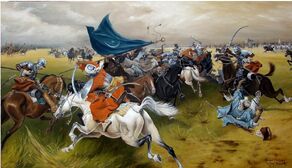
Battle of Antifakh, 1644
Knowing the Abbasid Caliphate was famed for their armies, the Rashidun kept all the same military structure and technology as it was used in the Sixth Fitna . As the military recovered from the civil war at the beginning of the 17th century, it was heavily upgraded to utilize the flintlock gunpowder technology, for both long range and short range weapons. Mortars and other heavy artillery were upgraded as well. The rest of the army, including the cavalry, infantry, and Kilab Al-Rub were kept identical to the former dynasty.
Expanding influence into the Indian Ocean, as well as the Atlantic Ocean, the Rashidun Caliphate expanded the navy to the largest extend of any Muslim dynasty. This work of expansion was primarily done by Admiral Reis Al-Nasser, possibly the greatest admiral of Muslim history. Al-Nasser worked for the Ulema in almost every naval campaign from the end of the Abbasid dynasty all the way into the height of the Rashidun. His memoirs document how he pioneered naval technology during the invasion of India in the Golden Jihad. He founded the naval academy of Aden in 1619, and there developed innovated technology for ships, such as the placement of mortars on galleys. In the 1620s, Nasser was the first to fit all ships with log tables, utilized for calculating maximum trajectory using calculus. The only navy that could rival the Rashidun was that of the Sulanate of Oman, which was then crushed at the Unificaiton of Arabia.
During the Great Turkish War, the Ottoman general Ismail Pasha took careful note of the more rigid formation and line infantry of the Tsardom of Belka. Ismail escaped from the disastrous Battle of Bayzapan in 1638, he reported to the Ulema in Damascus all of his findings, publishing the book Akher Al-Harb Al-Qadeem, or in English, "the End of Ancient Warfare". This completely revolutionized the military in the Caliphate, ultimately utilized to prevent Belka and the Crusaders from winning the war. At the Battle of Antifakh that ended the war, Pasha also developed battling in trenches as used by Salman Al-Fars in the original Rashidun Calipahte. After the Great Turkish war, Rashidun armies have been built for block formations per company, with line infantry fire.
Demographics[]
Language[]
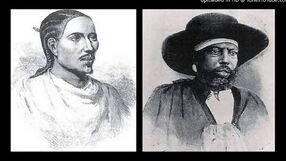
Amharic people
The vast majority of demographics within the Rashidun Caliphate consists of Semitic Ethno-Linguistic groups, also known as Afro-Asiatic groups. Indo-European minorities consist mainly of Iranians, absorbed from the Middle East after the Cloaked Jihad. The Iranians were spread across the Middle East and Arabia after the city of Tabriz was mostly destroyed in the war. Although systematically oppressed until the Rashidun Caliphate, they never disappeared. Other Indo-Europeans include the Kurdish people of northern Syria and Iraq, isolated from most of urbanization but never diminished either. Some immigration from Europe also exist in Egypt and the Levant in very tiny enclaves, mostly from Greece.
Turkic people, also known as Altaic or Turanian, were always considered the traditional bane of the Middle East ever since the Mamluks were overthrown by the Abbasid Restoration. Because of that, anything that could be construed of Turkic influence was outlawed, even the importation of Turkic slaves. Despite this, however, Turkic people migrated into Syria and Mesopotamia mainly during the latter half of the Abbasid period, creating a minority that continued into the Rashidun era. The immigration increased heavily during the Great Turkish War, but the Ulema worked very quickly to recruit the Turkish refugees into the invading army to resettle the region.
Within the Semitic languages that made up the majority of the Caliphate, these were subdivided in many ways. Amharic and many minor African languages continued unabated within the East African provinces, despite heavy Arab colonization in the region. During the Amharic Sojourn in the 17th century, this linguistic group migrated northward into Egypt in great quantities. Coptic and Hebrew are other Semitic languages that exist around Lower Egypt and Palestine, but both of these are generally restricted to liturgical circles.
Arabic makes up the majority of the Semitic languages used in the nation, but this is also not a single unit. The Rashidun consists of 16 dialects of Arabic, many of which is not fully understood by each other. As a result, in the 1660s the Ulema established the Council of Letters in Baghdad, which worked carefully with Bedouins of Arabia to discern a standardized version of Arabic that everyone can easily learn. This is now known as Modern Standard Arabic, or MSA.
Religion[]

Muslims worship at the Kaaba at Mecca
As a theocratic state at the head of Islam, organization of religion is extremely significant to the Rashidun Calipahte. The Rashidun considered themselves in the same way as the Papal States in Italy, as merely the personal property of the religious head. Caliphs would equally make legislations in religious matters as in secular ones. The most prolific occasion of this was Caliph Al-Ruqayya, who made many changes to the Friday liturgy while accommodating the Council of Basra. The Rashidun always saw themselves as the spiritual successor of the original Rashidun of the 7th century, and gave the appearance of conducting religion in the manner of that period. In 1601, Caliph Salih took special note of the 1000th anniversary of the conquest of Mecca in 630 AD.
Although Sunni Islam is important in that regard to the Caliphate, the Rashidun are most famous for their great enlightenment and openness of many different philosophies, due to the elective, participatory approach the Rashidun system offered. This is especially apparent in relation to the Shia factions. As the Shia-Sunni split, in effect for almost 1,000 years, was always a contention over the succession of Muhammad, the elective system made that succession a moot point.
Caliph Al-Ruqayya, in the Grand Council of Basra, formally offered the unity between Shia and Sunni. This was finalized after Ruqayya's death in 1615, when Caliph Ajead of the Ziyadi scholars was elected Caliph of Sunni Islam. This helped to further grow influence in Iran, as in 1634 Zarathustra was declared by the Ulema to be a prophet of the pre-Islamic period. Starting in 1638, Muslim scholars gleaned wisdom from the Avestan literature of Zoroastrianism, allowing that faith to grow in the far eastern provinces.
As with the Abbasid Dynasty, the Rashidun Caliphate considered Hinduism a mortal enemy, and continued the earlier Hindu-Muslim Wars started by Aryavarta to a whole new level. The Golden Jihad from 1603-1605 brought every Muslim nation to bear against the pagans in the Indian heartland, to the point of reviving the Indian Myth from medieval Musilm propaganda. Further east, the Caliphate managed to settle communities in southeast Asia for the proliferation of Islam, particularly in Malaya and southern China. The genocide of the Hui people under the Tan and Jin dynasties continued to hold a wedge between Islam and the Chinese traditional religion, but not to a significant level.
Christianity[]

Seat of the Coptic Papacy
The Coptic Church became very significant in the Rashidun dyansty. After the Arab-Ethiopian War, the Coptic population greatly increased in East Africa throughout the 16th century, and helped to take down the Abbasid dynasty in the Sixth Fitna. For this reason, the Rashidun Caliphate tried to remain on good terms with the Coptic papacy, and gave increased tolerance for it. As time progressed, more Amharic people from Ethiopia became more nomadic people across Egypt, a period known as the "Amharic Sojourn". This led to the Coptic Church creating a more complex hierarchical system to administer directly over the Churches across Africa.
Greek and Armenian Orthodoxy, especially within the Ottoman Empire, always caused a point of contention within the nation, especially during the western schism of the Hitlerite Wars. Other Christian communities within the Rashidun were given the same tolerance as they had within the Abbasids. For this reason, the Rashidun Caliphs reached out to grow closer to the Roman Pope, in order to balance the influence the Patriarch of Vasiligrad had on the Pentarchal Churches. In 1615, the Caliph sent the holy relic of the Pot of Abraham to the Pope, and in 1617 the Conference of Alexandria started a dialogue between the two faiths. This relation collapsed with the Great Turkish War, especially as the invading Belkan army brutally executed thousands of non-combatant Muslims. This earned the Orthodox as the expression of "Belkan Beasts".
Population[]
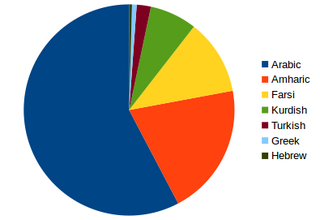
Demographic portions of the Caliphate
The combination of economic and political stability, coupled with the adoption of agricultural technologies, helped create a very high birth rate in the early part of the Rashidun era. After the end of the Sixth Fitna, the endangered life caused by the plagues and famines in the late 16th century caused a push towards more children to fill the gap. In addition, the increased emphasis on religion and philosophy created a much stronger focus on maintaining the family and extending patrilinial control to individual households. Therefore, this created a culture geared to population growth. After the invention of vaccination in the 1620s, this helped extend life expectancy and reduce infant mortality.
The population growth rate reached its peak of 2.1% around 1604, five years into the Rashidun dynasty. After that point, the birth rate leveled out for a long time for the first few decades of the 17th century. However, through the 1630s and into the 1640s saw a steady decrease in the birth rate to around 1.6%. After the Great Turkish War and near economic collapse that came from it, the rate dropped to 1.3% and continued decreasing.
In total, 42% of the population live in Africa while 58% live in Asia. Of those that live in Africa, however, only 53% are ethnically Arab. The remaining 47% of the African population are Amharic in ethnicity, comprising a total of 20% of the Caliphate's population. There are also 0.4% of the population who speak Hebrew, or about half the Jewish population. 2% of the population additionally are made of Turkic peoples immigrated from the Ottoman Empire, mostly after the Great Turkish War.
A total of 19.2% of the population are of Indo-European origin. 11.4% are decedent of Iranians that moved into the Middle East after the Cloaked Jihad. 7% originate from the native Kurdish population in northern Syria and Iraq. Finally, 0.7% are decedent from colonization and immigration from European Mediterranean over the centuries. The remaining 58% of the population is completely Arabic in origin, split into its various dialects.
Religious Demographics[]
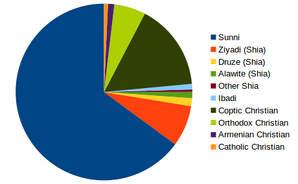
Religious diversity of the Caliphate
Religion paints a very similar diversity. 1% of the population adheres to Judaism. 23% of the population is Christian. 15.7% is under the Coptic Church, and another 5% adhere to various other Orthodox Churches. 0.7% follow the Catholic Church, and another 1.1% follow the Armenian Church. The remaining 76% of the population follows the Muslim religion of various sects. When the Rashidun Calipahte began, the Muslim population was 13.5% Shia, 1.2% Ibadi, and 85.3% Sunni. However, after the unification of Ziyadi and Sunni factions, the demographic changed to 3.8% Shia and 96% Sunni (or 74% of the total population).
In total, Ibadism makes up 1% of the population, living entirely in the Arabian peninsula. 10.4% are Shia in some form. 7.4% are of the former Ziyadi sect, while 1.4% adhere to the Druze sect of central Syria. An additional 1.1% follow the Alawite sect in southern Syria, and another 0.4% follow various minor Shia branches, including Jafari and Ismaili. The remaining 64% of the population follow complete Sunni theology.
Economy[]
The economy of the Rashidun Caliphate was largely inherited from the Abbasid Dynasty. The Bank of Cairo still held the largest share of finances, with a large emphasis placed on trade and exportation. Domestic products of export mostly include coffee, gold, and silver bullion, as well as cotton and perfumes. More manufactured products include works of art and tapestry. More exact products vary between markets exported to. Agriculture was also the backbone of the economy just as it was in previous dynasties. The Rashidun kept the same 'iqta system of taxation the Abbasids used. Cotton was first imported from India after Gujarat was vassalized in the Golden Jihad. By the mid 17th century, cotton was fully planted in Egypt as a local domestic product.
Indian Ocean[]

Indian cotton
The Rashidun Caliphate envisioned a goal to completely dominate the Indian Ocean, as the Gurkani Sultanate did in their time, and monopolize trade across between Africa, Europe, and Asia. The Arab-Indian Company continued in the same way it did before, as well as trade across the seas as far as China and Korea. In fact, the sea trade to the far east was so massive by this point, that the former Compact of Beyrut (based on overland trade) was completely abandoned.
One of the main exports unique to the Indian Ocean trade was based on African slavery. Slavery had been a large part of the Muslim dynasties for thousands of years, but from the very beginning of the Rashidun Caliphate they worked towards its complete abolition. The beginning of the 17th century showed a gradual transition towards the French model of contracted servants, until all exports were stopped in 1608. In 1617, after the Unification of Arabia, the practice was formally made illegal. This completely stopped the slave trade across North Africa until the late 17th century. However, by 1624 Swahili and Oman began resuming the trade outside of the Calipahte's control.
A large part of establishing control over the Indian Ocean was creating colonial possessions in India. The ongoing Hindu-Muslim Wars came to a head in 1602, when Aryavarta broke the peace of India to take the Andaman islands from Burgundy. The resulting Golden Jihad completely pushed Aryavarta from the coastlines of India, and seized all their possessions in the Indian Ocean. Aryavarta would continue to fight back in subsequent wars as well, but this was the main turning point of Muslim dominance on the seas.
The Strait of Malacca, situated between Malaya and Sumatra, was therefore extremely important to maintain this connection. Although Malaya was a protectorate of Burgundy, the combined colonies of Sumatra, Aceh, Andaman, and Chittagong helped to establish tight control over the straits. In general, the Kingdom of Burgundy remained the largest rival to the Caliphate for control over Southeast Asia, as well as influence in East Asian economy.
During the Unification of Arabia in 1615, the rogue Omani navy loyal to the exiled Nabhani Dynasty in Qamar waged a war at sea against the Rashidun navy, turning into pirates. After Oman was re-unified as a Rashidun vassal, the Qamarid Pirates continued to become a staple as well as a thorn of trade in the Indian Ocean. However, starting in 1618 the pirates were employed as privateers by Oman and the Rashidun to reek havoc for Burgundy.
Mediterranean[]
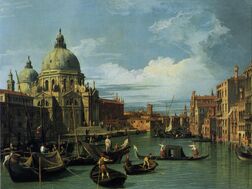
Harbor of Venice
Trade through the Mediterranean sea was also very important to the Rashidun Caliphate, as it was carried over from the Abbasids. Exported goods to the west mainly goes to the older allies of the Caliphate, namely France and Belka. Smaller trade also existed for Iberia and Venice, but these were more sporadic depending on Europe's political situation. The Treaty of Tunis, which had leased the Gibraltar peninsula to Iberia for 99 years after 1525, was renewed in 1614, in order to keep peaceful relations there. In general, after the age of exploration killed the Silk Road, the Rashidun was much less concerned about directly trading with Europe as previous Egyptian dynasties had done. Rather, the Caliphate focused on its Indian colonies and expanded trade pushing eastward to China.
Because of this, the Rashidun allowed its vassals of Morocco, Cyprus, and Turkey to keep control over the trade in the White Sea. Morocco was the source of Barbary pirates harassing the states of Iberia and Italy. The Ottomans, in the middle of the remaining Orthodox nations, controlled trade in the Black sea with its own colony of the Crimean Khanate, until that was given to the Kingdom of Pontus. Cyprus remained the largest source of Mediterranean trade, and in the Great Turkish War it succeeded to defend the eastern White Sea against multiple attempted attacks by Belka.
After the naval campaigns in the Sixth Fitna and Golden Jihad, the Rashidun resumed construction of the Fatha Al-Farun in the Sinai peninsula, which had been abandoned by the Abbasids. The canal was finished construction in 1611, but it remained under the direct control of the Caliph with restricted access to a small selection of ships from Europe. At the Conference of Alexandria, the Roman Pope was personally given permission to utilize the canal.
Atlantic Ocean[]
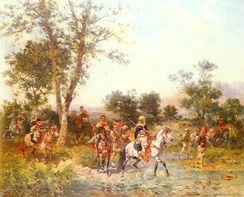
Berber colonists in Laurentia
Starting in 1601, the Sultanate of Africa centered at Morocco began sending expeditions to colonize the New World, specifically Laurentia. This was mainly done to match the wealth and influence Arabia had over the Indian Ocean by having its own path to Asia. The largest colony Morocco possessed was the Tajamanid Emirate, located on the most southern tip of the continent. This was created by colonizing and vassalizing the native Ona people of the Bonapaarta Straits. The second largest colony owned by Morocco was the Oyo Emirate, a section of the coast of West Africa taken during Benin's civil war.
Morocco had acquired various other smaller ports across the Atlantic Ocean and West African coast as well, but these were frequently exchanged as the economy permitted. At one period in the 1630s, the Kingdom of Arawaka in Brazil was made a protectorate of Morocco, and its population converted to Islam.
The Zulu empire formed in the 1610s offered a native African nation to accept trade from the Rashidun Caliphate. In the 1630s, Shaka Zulu toured the Caliphate to acquire more technology and open diplomacy. From 1639-1646, the explorer Salah Ibn Tulun circumnavigated the globe by journeying westward through the Bonapaart Straits, across the Pacific Ocean, then through the strait of Malacca to enter the Indian Ocean back to the Caliphate. Ibn Tulun proved that he could encircle the globe without ever leaving the Caliph's domains.
Culture[]
Literature[]
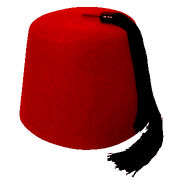
A typical fez
The Rashidun Caliphate kept a culture based on enlightenment and diversity, which ultimately became a mixture of the Old Abbasid Caliphate and the Fatimid Caliphate in its cultural basis. In the 1620s, the Ulema pushed to update the Library of Alexandria and the House of Wisdom in Baghdad to hold copies of all books around the world up to the latest science and technology. One symbol of this cultural shift was the adoption of the fez, a traditionally Turkish headdress, which quickly replaced the turban as the main head covering within the first decade of the 17th century. Beyond being the most popular hat, the fez quickly became a cultural icon of the Rashidun Caliphate and its society in general.
Another cultural icon was the Pan-Islamic Games, a series of competitions loosely based on the Olympics held at the city of Mecca. The Islamic Games thrived on the vast geographic expanse of the Rashidun's influence, picking up athletes from as far away as Laurentia and Busan. However, it was actually only held once in 1618 and never formally organized.
Delving back into its Semitic roots of oral tradition, works of ballads and poetry was very important to the Rashidun Caliphate. Sonnets, the distinctive poem of 14 lines, was brought from England starting in 1600. The various wars of expansion conducted by the Rashidun also included their own ballads. The most famous example of this was the Ballad of Bahla, romanticizing how general Mustansir Al-Obied fought bravely against the Rashidun forces during the Unification of Arabia. Various other stories exist within the Rashidun romanticizing the lives of Al-Ankhabut, Ibn Tulun, and Al-Najm the Great.
The most famous works of prose were generally about military service and the expansion of Islam. During the Golden Jihad from 1602-1605, the old anti-Hindu propaganda was exemplified in the popular dissertation Wars of Pagan India. During the war itself, the Admiral Reis Al-Nasser composed his personal memoirs detailing the style and conditions of fighting in that region. This was later complemented by Ismail Pasha's work during the Great Turkish War, The End of Ancient Warfare.
Chronicles and other works of history were also extremely famous during the Rashidun era. In 1617, the Tarikh Al-Farun (History of the Pharaohs) compiled a complete history of Pre-Achamenid Egypt utilizing the sources compiled during the Abbasid dynasty. Ancient Egyptian history was best understood by the Rashidun era due to the translation of Hieroglyphs generations earlier. After Persia became a vassal in 1630, archaeological expeditions into the nation uncovered much more information of the Empire's history, discovering what is believed to be the grave of Zoroaster in 1633. In 1635, a complete history of the Mamluk Sultanate was compiled to remember the era that founded the modern Caliphate. In 1667, these previous histories were combined as source material to compile a complete history of the Caliphate from 1400 to the present day, a total of 267 years.
Science and Technology[]
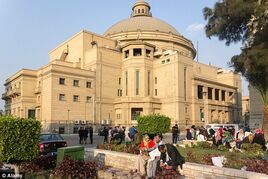
Cairo University
Stemming from the enlightenment culture of the Rashidun era, there also grew a desire for more education and scientific advancement. Education for both elementary and advanced levels were expanded on a national scale starting in 1601, and the emphasis continued until the 1620s. This took off much faster when the Tomb of Al-M'ustasim II, the last Abbasid Caliph of Baghdad, was discovered in 1603. His great store house of books greatly contributed to the base of the Rashidun.
Printing became very significant for the proliferation of knowledge, as the first scientific journal was published in 1626. In general, the knowledge and scientific advancement of the Caliphate quickly became the standard of development across the western world.
Mathematics were one of the first significant developments of the new generation. The most significant of these mathematicians, Mahmud Al-Msr, flourished from about 1614-1618. He developed the system of mathematics started by Al-Babil to formally establish the modern system of calculus. In 1617, he invented the function of logarithm which was instrumental to naval technology. In 1618, he published his findings related to calculus and geometry in Al-Owelaid ("The Principles") in Alexandria. In the 1620s, this formed the basis of Euclidean philosophy that restructured education and the scientific method. In the new system, ideas are all scrutinized using a system of previously-proven ideas similar to Euclidean geometry.
Astronomy was also greatly developed during this time. Astronomy had continued to be developed since the Abbasids, but it wasn't until 1620 that the telescope was introduced to the Middle East. Simultaneous to this was the adoption of the heliocentric model of the universe, replacing centuries of geocentric ideas. In 1621, Al-Msr's calculus was applied to astronomy to create mathematical models for planetary motion. In 1622, the first proposal was made that the universe is infinite in size, which is still a matter of controversy in the Caliphate to this day. Later in the 1620s, the planets of Uranus and Neptune were discovered with the telescope.
Develops of both biology and chemistry came later than these first achievements. The Ulema authorized the dissection of corpses for the use of science in 1613. Since the Abbasid plagues in the late 16th century, cholera was a constant threat under the Rashidun Caliphate. In the 1620s, the biologist Khalid Al-'Ab took special note of the use of shellfish in relation to outbreaks of cholera. Using these observations, Al-'Ab eventually perfected a system of inoculation which is the basis of modern vaccines. This revolutionized the field of medicine in the Caliphate, who proliferated the technology across its trade partners in Africa. In the field of chemistry, the original concept of four elements related to Platonic solids was abandoned starting in 1620. Throughout the next decade, new elements were isolated and added to the growing list, including chlorine, platinum, and bismuth.
Art and Architecture[]
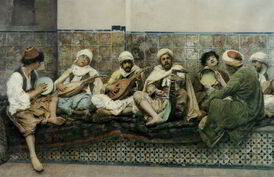
Typical Arab musicians
The Rashidun Caliphate was set unique from all previous forms of art by adopting the Baroque style, featured in both their painting, architecture, and music. After the transformation of art into the Renaissance in the Abbasid dynasty, the Rashidun culture perfectly melded with the Baroque style, and by the 1660s took baroque art to a level rivaling some European nations. Many native works of art had already existed, most notably the export of elaborate rugs and tapestries, and that still continued through this era. However, it was largely overshadowed by the introduction of Baroque style.
Baroque painting was typified by dramatic expressions overlaid with exaggerated lighting and shade. The first works of these paintings were murals depicting scenes of the Qu'ran, added to royal residences starting in 1604. Starting in 1608, Ismail Ibn Ishaq revolutionized the use of portraiture by utilizing baroque style in depicting real life people. Some of the most famous works of baroque painting include the School of Baghdad in 1609, anachronistically depicting Islamic scholars from across the history of the Muslim world, as well as The Night Watch in 1618.
Starting in 1607, baroque architecture took off to re-imagine the construction behind Grand Mosques, the cathedrals of the Muslim world. Several mosques that were once built by the Abbasids, including the Grand Mosque of Antioch, were rebuilt for emphasis on colonnades, spires and shade. After the Korean-Japanese War destroyed the Mosque of Busan in 1610, merchants were imported from the Rashidun to reconstruct the enclave using the new baroque style. By the late 1610s, the size and majesty of Rashidun city-planning worked hard to compete with the growing urbanization of their cultural neighbor, the Tsardom of Belka. By the end of the decade, Grand Mosques resembled western Churches in many ways stylistically.
In the late 1620s, there was a push by the new generation to reconstruct lost wonders of the Ancient World with modern technology. From 1628-1631, the Lighthouse of Alexandria was officially reconstructed from the ground up, completely replacing the tower originally built by the Abbasids. Although completely not functional as a lighthouse, the new building served more as the grandest showcase the baroque use of void and lighting, as well as creating a symbol of the Rashidun innate superiority.
In Mesopotamia, the Hanging Gardens of Babylon was also rebuilt in the city of Al-Babil, specifically in the garden plaza of the palace for the Ayatollah of Baghdad. Designed by the agricultural society of the House of Wisdom, a brick maze within the plaza was fitted with shelves that blend in with the walls, giving the appearance the plants are suspended in air.
Music was also a significant feature of the baroque era, focusing on quick variation and melody to create music easy to dance and sing to. This also capitalized on the developments of new technologies to produce music, specifically the violin, viola, cello, as well as the harpsichord. The polyphonic composition of the fugue, typical of the baroque style, was introduced in the 1630s.
Footnotes[]
| |||||||||||||||||||
| |||||||||||||||||||||||||||||||||||





